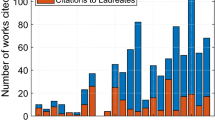Abstract
In 1923, R.A. Millikan was awarded the Nobel Prize in Physics for his work on the elementary charge of electricity and on the photoelectric effect. Recently, historical research had a focus on Millikan’s publication practice, as well as on the role of his assistant, Harvey Fletcher. Several studies have raised doubts on whether Millikan can actually be taken as a role model for scientific practice; however, what has not been discussed yet is the question of how the Nobel Committee came to their decision to award Millikan’s work. Based on archival material from the Nobel Committee, this paper discusses the nomination procedure, as well as the evaluation process of Millikan’s work.
Similar content being viewed by others
References
Bömmel, H. (1994). Edgar Meyer. In Neue Deutsche Biographie (Vol. 17, pp 331-332). Berlin, DE: Melander–Moller.
Crawford E. (2002) The Nobel population 1901-1950 – A census of the nominators and nominee for the Prizes in physics and chemistry. Universal Academy Press, Inc., Tokyo, JP
Crawford, E., Heilbron, J.L., Ullrich, R. (1987). The Nobel population 1901-1937 – A census of the nominators and nominee for the prizes in physics and chemistry. Uppsala, SE: Office for History of Science, Uppsala University.
Chwolson O.D., Schmidt G.K. (1902) Lehrbuch der physik. F. Vieweg & Sohn, Braunschweig, DE
Eckert M. (1993) Die atomphysiker: Eine geschichte der theoretischen physik am beispiel der Sommerfeldschule. Vieweg, Braunschweig/Wiesbaden, DE
Elzinga, A. (2006). Einstein’s Nobel Prize: A glimpse behind closed doors: The archival evidence. (Archives of the Nobel Museum, 6). Sagamore Beach, MA: Science History Publications, U.S.A.
Eshach, H. (2008). The Nobel Prize in the physics class: Science, history, and glamour. Science & Education, (Electronic edition) August 14, 2008. DOI:10.1007/s11191-008-9172-4
Fant, K. (1995). Alfred Nobel – Idealist zwischen wisenschaft und wirtschaft (Aus dem Schwedischen vom Wolfgang Butt). Basel, CH: Birkhäuser Verlag.
Fletcher, H. (1982, June). My work with Millikan on the oil-drop experiment. Physics Today, 43-47.
Friedman R.M. (1989) Appropriating the weather: Vilhelm Bjerknes and the construction of a modern meteorology. Cornell University Press, Ithaca, NY
Friedman R.M. (2001) The politics of excellence: Behind the Nobel Prize in science. Times Books, New York
Friedman, R.M. (2002). Quantum theory and the Nobel Prize. Physics World, 15, 33-38. Retrieved June 15, 2008 from http://physicsworld.com/cws/article/print/9551
Klassen S. (2007) Pedagogical renewal of Millikan’s oil drop experiment. In: Heering P., Osewold D. (eds) Constructing scientific understanding through contextual teaching. Berlin DE, Frank & Timme, pp 83–95
Küppers G., Weingart P., Ulitzka N. (1982) Die Nobelpreise in physik und chemie 1901-1929. Materialien zum Nominierungsprozess. Bielefeld, DE, B.K. Verlag
Marsch, U. (1994). Notgemeinschaft der Deutschen Wissenschaft: Gründung und frühe Geschichte, 1920 – 1925. Münchner Studien zur neueren und neuesten Geschichte, Bd. 10. Frankfurt am Main, DE: P. Lang.
Niaz M., Rodriguez M.A. (2004) The oil drop experiment: An illustration of scientific research methodology and its implications for physics textbooks. Instructional Science 32: 357–386
Nielsen, H., Nielsen, K. (eds) (2001) Neighboring Nobel: The history of thirteen Danish Nobel Prizes. Aarhus University Press, Aarhus, DK
Parlow, V. (2006). Reflektion und analyse der rezeption des Millikan- Experiments zur bestimmung der elementarladung unter besonderer Berücksichtigung didaktisierender aspekte. Unpublished doctoral dissertation. University of Oldenburg, Oldenburg, Germany.
Singh R., Riess F. (1998) Sir C.V. Raman and the story of the Nobel Prize. Current Science 75: 965–971
Statutes of the Nobel Foundation (SNF 1995).67
Statutes of the Nobel Foundation (SNF-Special regulations 1994). Statutes containing special regulations for the award by the Royal Swedish Academy of Sciences of Prizes from the Nobel Foundation.
Author information
Authors and Affiliations
Corresponding author
Rights and permissions
About this article
Cite this article
Panusch, M., Heering, P. & Singh, R. How Robert A. Millikan Got the Physics Nobel Prize. Interchange 41, 425–442 (2010). https://doi.org/10.1007/s10780-010-9139-7
Published:
Issue Date:
DOI: https://doi.org/10.1007/s10780-010-9139-7



